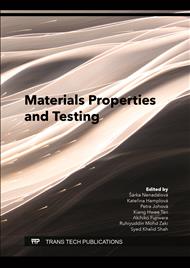[1]
R. Narayan, U. Y. Nayak, A. M. Raichur, and S. Garg, Mesoporous silica nanoparticles: A comprehensive review on synthesis and recent advances,, Pharmaceutics, vol. 10, no. 3, p.1–49, 2018,.
DOI: 10.3390/pharmaceutics10030118
Google Scholar
[2]
G. Batrinescu, L. A. Constantin, A. Cuciureanu, and M. A. Constantin, Conductive Polymer-Based Membranes,, in Conducting Polymers, InTech, (2016).
DOI: 10.5772/63560
Google Scholar
[3]
Y. Ko, H. Y. Jeong, G. Kwon, D. Kim, C. Lee, and J. You, pH-responsive polyaniline/polyethylene glycol composite arrays for colorimetric sensor application,, Sensors Actuators, B Chem., vol. 305, no. August 2019, p.127447, 2020,.
DOI: 10.1016/j.snb.2019.127447
Google Scholar
[4]
R. Chen, F. Yang, Y. Xue, X. Wei, L. Song, and X. Liu, Polypyrrole confined in dendrimer-like silica nanoparticles for combined photothermal and chemotherapy of cancer,, RSC Adv., vol. 6, no. 45, p.38931–38942, 2016,.
DOI: 10.1039/c6ra03314h
Google Scholar
[5]
L. Wang, X. Han, J. Li, L. Qin, and D. Zheng, Preparation of modified mesoporous MCM- 41 silica spheres and its application in pervaporation,, Powder Technol., vol. 231, p.63– 69, 2012,.
DOI: 10.1016/j.powtec.2012.07.044
Google Scholar
[6]
X. Zhu, J. Zhao, and C. Wang, Acid and base dual-controlled cargo molecule release from polyaniline gated-hollow mesoporous silica nanoparticles,, Polym. Chem., vol. 7, no. 42, p.6467–6474, 2016,.
DOI: 10.1039/c6py01507g
Google Scholar
[7]
S. M. Shawky, A. A. Abo-alhassan, H. Lill, D. Bald, S. F. El-khamisy, and E. M. Ebeid, Journal of Nanosciences : Current Efficient Loading and Encapsulation of Anti- Tuberculosis Drugs using Multifunctional Mesoporous Silicate Nanoparticles,, vol. 1, no. 1, p.1–9, 2016,.
Google Scholar
[8]
A. Banerjee and A. K. Shukla, Studies on 12 V substrate-integrated lead-carbon hybrid ultracapacitors,, J. Chem. Sci., vol. 127, no. 5, p.967–977, 2015,.
DOI: 10.1007/s12039-015-0852-8
Google Scholar



